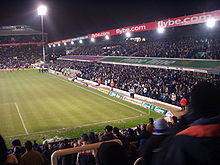Small Heath Alliance played their first home games on waste ground off Arthur Street, Bordesley Green. As interest grew, they moved to a fenced-off field in Ladypool Road, Sparkbrook, where admission could be charged. A year later, they moved again, to a field adjoining Muntz Street, Small Heath, near the main Coventry Road, with a capacity of about 10,000. The Muntz Street ground was adequate for 1880s friendly matches, and the capacity was gradually raised to around 30,000, but when several thousand spectators scaled walls and broke down turnstiles to get into a First Division match against Aston Villa, it became clear that it could no longer cope with the demand.[64]
Director Harry Morris identified a site for a new ground in Bordesley Green, some three-quarters of a mile (1 km) from Muntz Street towards the city centre. The site was where a brickworks once operated; the land sloped steeply down to stagnant pools, yet the stadium was constructed in under twelve months from land clearance to opening ceremony on Boxing DayMiddlesbrough, could go ahead.[64] The ground is reputed to have been cursed by gypsies evicted from the site;[65] although gypsies are known to have camped nearby,[66] there is no contemporary evidence for their eviction by the club. 1906. Heavy snow nearly prevented the opening; volunteers had to clear pitch and terraces before the match, a goalless draw against
The original capacity of St Andrew's was reported as 75,000, with 4,000 seats in the Main Stand and space for 22,000 under cover.[64] By 1938 the official capacity was 68,000, and February 1939 saw the attendance record set at the fifth round FA Cup tie against Everton, variously recorded as 66,844 or 67,341.[B] On the outbreak of the Second World War, the Chief Constable ordered the ground's closure because of the danger from air raids; it was the only ground to be thus closed, and was only re-opened after the matter was raised in Parliament. It was badly damaged during the Birmingham Blitz: the Railway End and the Kop as a result of bombing, while the Main Stand burnt down when a fireman mistook petrol for water.[64]
The replacement Main Stand used a propped cantilever roof design, which meant fewer pillars to block spectators' view of the pitch. Floodlights were installed in 1956, and officially switched on for a friendly match against Borussia Dortmund in 1957.[67] By the early 1960s a stand had been built at the Railway End to the same design as the Main Stand, roofs had been put on the Kop and Tilton Road End, and the ground capacity was down to about 55,000.[67]
Resulting from the 1986 Popplewell Report into the safety of sports grounds and the later Taylor Report, the capacity of St Andrew's was set at 28,235 for safety reasons,[29][67] but it was accepted that the stadium had to be brought up to modern all-seated standards. After the last home game of the 1993–94 season, the Kop and Tilton Road terraces were demolished – fans took home a significant proportion as souvenirs – to be replaced at the start of the new season by a 7,000-seat Tilton Road Stand, continuing round the corner into the 9,500-seat Kop which opened two months later.[64] The 8,000-seat Railway Stand followed in 1999[68] – ten years later, this was renamed the Gil Merrick Stand, in honour of the club's appearance record-holder and former manager[69] – but the Main Stand has still to be modernised. As of 2010, the stadium capacity is 30,009.[1]
In 2004 a proposal was put forward to build a "sports village" comprising a new 55,000 capacity stadium for the club, to be known as the City of Birmingham Stadium, other sports and leisure facilities, and a super casino. The project would be jointly financed by Birmingham City Council, Birmingham City F.C. (via the proceeds of the sale of St Andrew's) and the casino group Las Vegas Sands. The feasibility of the plan depended on the government issuing a licence for a super casino, and Birmingham being chosen as the venue,[70] but this did not happen. The club have planning permission to redevelop the Main Stand,[71] but club and council have continued to seek alternative sources of funding for the City of Birmingham Stadium project.[72]
[edit] Supporters
Birmingham fans consider their main rivals to be Aston Villa, their nearest neighbours geographically, with whom they contest the Birmingham derby. Lesser rivalries exist with fellow West Midlands clubs Wolverhampton Wanderers and West Bromwich Albion. According to a 2003 Football Fans Census survey, Aston Villa fans think of Birmingham City as their main rivals, though this has not always been the case.[73]
Birmingham's supporters are generally referred to as "Bluenoses" in the media and by the fans themselves; the name is also used in a derogatory manner by fans of other clubs.[74][73] A piece of public sculpture in the form of a ten-times-life-size head lying on a mound near the St Andrew's ground, Ondré Nowakowski's Sleeping Iron Giant, has been repeatedly defaced with blue paint on its nose.[75][76] Between 1994 and 1997 the club mascot took the form of a blue nose,[77] though it is now a dog called Beau Brummie, a play on the name Beau Brummell and Brummie, the slang word for a person from Birmingham.
There are a number of supporters' clubs affiliated to the football club, both in England and abroad.[78] While an action group was formed in 1991 to protest against chairman Samesh Kumar,[31] the club blamed an internet petition for the collapse of the purchase of player Lee Bowyer in 2005,[79] and antipathy towards the board provoked hostile chanting and a pitch invasion after the last match of the 2007–08 season,[80][81] relations between club and fanbase have never been so poor as to provoke the formation of an independent supporters' group. When the club was in financial difficulties, supporters contributed to schemes which funded the purchase of players Brian Roberts in 1984[82] and Paul Peschisolido in 1992.[31]
There have been several fanzines published by supporters; in 2008, two were regularly on sale, Made in Brum, first issued in 2000, and the longer-established Zulu. The hooligan firmZulus, were unusual in that they had multi-racial membership at a time when many such firms had associations with racist or right-wing groups.[83][84] The 2005 film Green Street features hooliganism surrounding a fictional match between West Ham United and Birmingham. associated with the club, the
The fans' anthem,[85] an adaptation of Harry Lauder's Keep right on to the end of the road,[86]The Times' football correspondent described in his Cup Final preview how was adopted during the 1956 FA Cup campaign.
the Birmingham clans swept their side along to Wembley – the first side ever to reach a final without once playing at home – on the wings of the song "Keep right on to the end of the road".[87]
Player Alex Govan is credited with popularising the song, by singing it on the coach on the way to the quarter final,[88] and when he revealed in an interview that it was his favourite.
In the build-up to the 1956 FA Cup semi-final with Sunderland I was interviewed by the press and happened to let slip that my favourite song was Harry Lauder's old music hall number "Keep Right on to the End of the Road". I thought no more about it, but when the third goal went in at Hillsborough the Blues fans all started singing it. It was the proudest moment of my life.[89]









Comments
0 comments to "Birmingham City Football Club - Stadiums"
Đăng nhận xét